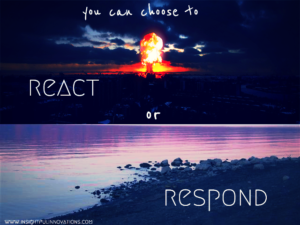 Here’s Mr. Oil and Mr. Water staring at each other across the desk. Both are replaying a video of themselves in their youth in the same emotional situation. One’s getting harassed for underperforming, and the other’s on the offense, because that was (and is today) his role and makes his world work the way he wants it to.
Here’s Mr. Oil and Mr. Water staring at each other across the desk. Both are replaying a video of themselves in their youth in the same emotional situation. One’s getting harassed for underperforming, and the other’s on the offense, because that was (and is today) his role and makes his world work the way he wants it to.
Allowed to play out, the dialog that develops between these two (and husbands and wives and parents and kids) will most likely follow the same pattern it’s followed for years. One individual, locked in their Knower/Judger response patterns, will elicit the same response from the other individual locked in their K/J response patterns. There’s virtually no hope that anything different will happen than has happened in the past. It’s a downward spiral and actually, with repeated experiences, becomes easier and easier to reach the level of dysfunctional faster.
Everything can change if either of these individuals wants a different outcome and realizes that, even though the dynamic appears totally dysfunctional, it fits both combatants’ comfort zones. (“See, I knew he was gonna be mad at me.”). The pattern can be broken and a new, more productive pattern engaged.
Consider Viktor Frankl’s quote from his book Man’s Search for Meaning: “Between stimulus and response there is a space. In that space is our power to choose our response. In our response lies our growth and our freedom.”
Let’s assume Harold wants a different outcome from slinking out of the supervisor’s office with his head in his hands. What can he do?
Let’s play the scene differently.
Harold walks into the supervisor’s office and the supervisor lays out the first shot. Harold’s programmed response is to emotionally back up and get defensive, right? That will take the conversation where it’s always gone before.
The supervisor’s opening gambit is the stimulus.
“Between stimulus and response there is a space.” In that space, Harold can (if he really wants to) choose a different response. It’s choice over reaction. What are his options? Well, just about anything will derail the programmed dialog that has occurred dozens of times in the past. He can suggest, “You appear concerned…”, and await the response. He can say, “You’re right,” and sit silent while the supervisor hunts for something to say since he didn’t get his expected response. See how Harold can choose something different in order to develop a different route for this dialog to go?
What could the supervisor do if he wanted a different outcome. Let’s say the opening stimulus is Harold walking in with the incomplete project files. The supervisor’s normal reaction is to voice criticism, but he could do something different in his space. He could suggest that he knows Harold had extra work assigned to him and ask what other resources Harold needs to get the project done as quickly as possible. He could ask Harold how his son did in the basketball tournament last weekend.
The key to either of these gentlemen breaking the pattern is to be aware of two things: 1) That they are about to react how they always react and 2) That they’re in the space between stimulus and response and that doing or saying anything different from what they’d normally do or say will change the outcome.
It’s that simple.
It’s not that easy.
Try it. Spouse, boss, son, daughter, direct report. When you’re about to give the other participant your normal reaction, stop. Recognize it’s that holy space between stimulus and what happens next. Use that moment to choose something else. Anything else. It can be meaningful. It can be funny. It can be off topic. It will change the pattern. If that’s what you want.



